In one of the great astronomical discoveries, scientists have said they made direct observation of gravitational waves – ripples in space-time foretold by Albert Einstein 100 years ago.
Physicists said the detected gravitational waves were produced during the final fraction of a second of the merger of two black holes – that were about 29 and 36 times the mass of the sun, to produce a single, more massive spinning black hole. This collision, which happened about 1.3 billion years ago had been predicted but never observed, according to the National Science Foundation.
The gravitational waves were detected on 14 September 2015 at 5:51am EDT by both of the twin Laser Interferometer Gravitational-wave Observatory (LIGO) detectors.
LIGO consists of twin instruments, located 1,865 miles apart in Louisiana and Washington. Each of these instruments involves a single laser, each directed into two 4km-long arms that run perpendicular to one another. As a gravitational wave passes through a detector, it distorts space-time such that one arm lengthens, and the other shortens. By comparing the disturbances at the two detectors, the scientists can confirm the direct detection of a gravitational wave.
“Gravitational waves carry completely new information about black holes and other cosmic objects, and they will unlock a new part of the universe,” said Northwestern University’s Vicky Kalogera, an expert in black hole formation in binary systems and LIGO data analysis.
According to general relativity, the NSF says, a pair of black holes orbiting around each other lose energy through the emission of gravitational waves, causing them to gradually approach each other over billions of years, and then much more quickly in the final minutes. During the final fraction of a second, the two black holes collide at nearly half the speed of light and form a single more massive black hole, converting a portion of the combined black holes’ mass to energy, according to Einstein’s formula E=mc2. This energy is emitted as a final strong burst of gravitational waves. These are the gravitational waves that LIGO observed.
IDG News Service








Subscribers 0
Fans 0
Followers 0
Followers